![]()
![]()
C L I M A T I C F E A T U R E S
It is a hot, sultry day. The scorching southern sun is beating down
mercilessly. The asphalt feels soft under the feet in the streets of Yerevan.
The people are suffering from the oppressive heat. But south of the capital the
Holy Mount Ararat -- the Free Masis --covered with permanent snow and ice, rises majestically. Sultry summer
and eternal winter exist almost side by side.
H I G H L A N D S O F A R A R A T
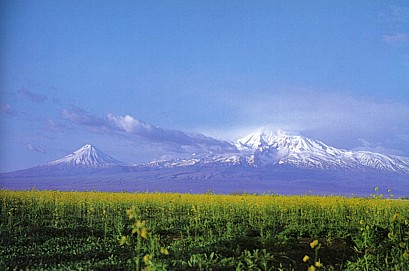
HOLY MOUNT ARARAT --
VIEW FROM THE ARARAT
VALLEY
In Armenia it is sometimes possible to find all the four seasons at the same time. When succulent apricots, peaches and grapes, from which some of the world's best brandies and wines are made, are ripening in the Ararat valley, high on the mountain slopes which surround the valley there is not enough heat even for grain to ripen, while still higher there are places covered with snow all the year round.
![]()
It may be concluded on the basis of archaeological data and the information
furnished by ancient Greek and Armenian historians that the climate of the
Armenian Plateau has changed very little from the historical times. The karas (very
large clay vessels for wines), the apricot and peach pits and grape seeds found
in the excavations of the Ararat (Urartu) fortress of Teishebaini, Karmir-Blur
district (near Yerevan) show that in the distant past too the climate of the
Ararat Valley was characterized by hot, dry summers. This is also attested to by
remains of ancient irrigation canals, some of which have been restored and are
in operation today.
The climate of the middle mountain steppe zone was similarly moderate in the
past, and grain crops were grown there in olden times, as they are today. This
is confirmed by the grains of wheat found in the burial grounds of Lchashen
(near Lake Sevan).
According to historical sources, in ancient times the winter was, as it is now, fairly cold in the Armenian lowlands and rigorous high in the mountains. Xenophon, the Greek historian (4-th century B.C.), in his Anabasis (The Retreat of the 10,000), which describes the retreat of 10,000 Greek mercenaries through the Armenian mountains in the autumn, relates that at night, when the soldiers were asleep, snow fell in the mountains and covered the men and their weapons. He writes that the snow that fell in one night was about one meter deep. In the same work he notes that the Armenians protected themselves against the frost by rubbing fat or almond oil into their bodies. One can get some idea of the variety of climates in ancient Armenia by reading Plutarch. For example, he explains the reasons for the retreat of the Roman General Lucullus (lst century B. C.) by the fact that in the Armenian lowlands where summer was at its height the troops found plenty of food but after climbing the mountains, where the grain had not yet ripened, they starved and had to abandon the country. Interesting information on the climate of Armenia is furnished by the Armenian historian Mowses Khorenac‛i (Mowsēs of Xorēnē) (5th century A. D.) . He described the climate of the Ararat plain as hot and dry in the summer and
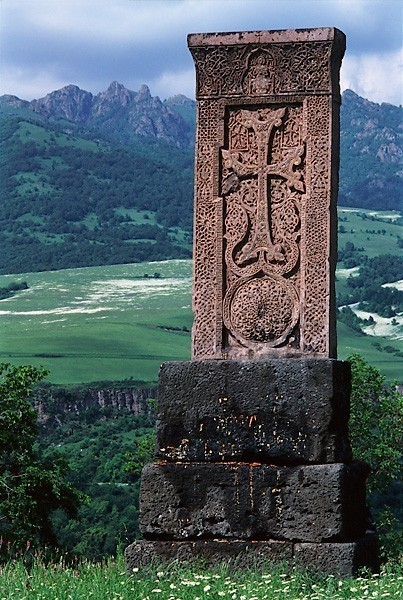
THE 'SIRUN' [BEAUTIFUL] CROSS-STONE OF DSEGH
VILLAGE, NORTHERN ARMENIA
cold
in the winter. mild in the mid-mountain zone, which already then was the place
where the nobility spent the summer, and rigorous in the highlands. Armenia is
located on the northern limit of the subtropical zone, in latitudes clearly
manifesting the general features of a dry continental climate. But the complex
mountain relief is responsible for the marked differences in the climate.
Ivan Shopen, Russian statistician and explorer of the Caucasus, who traveled
through Armenia at the beginning of the 19th century, wrote: "In the Armenian
region the traveler may in one day pass from an area of polar frost to one of
tropical heat, i.e., travel almost one-quarter round the world'. All the
climates in the vast European part of the CIS can also be found on the small
territory of the Republic of Armenia is referred to as the Sunny Republic;
because of the country's southern location, considerable absolute elevation and
the striking purity of its air, the solar radiation is very intense.
Those sun-worshipper tourists who come to our Republic and spend even a short time in the mountains go back beautifully and evenly sun-tanned. The cool, clear air, and the abundance of ultra-violet rays, make the mountain climate of Armenia very healthy. The duration of sunshine is very long-an average of 2,500 hours a year.
The Ararat plain and the Sevan basin have the longest duration of
sunshine-about 2,700 hours a year. Alexandria in Egypt does not have many more;
the shortest duration of sunshine is in mid-mountain areas of the forest zone
(about 2,000 hours). In the foothills there is hardly a sunless day between June
and October.
Various air masses -with different physical properties are partly responsible
for the climate of the Republic.
Armenia is 190 km from the Caspian Sea and 160 km from the Black Sea but these two seas exert an appreciable influence on its climate. The decisive role, however, is played by the air masses which bring moisture from the temperate latitudes of the distant west.
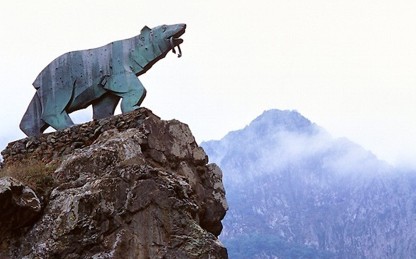
I N T H E H I
G H L A N D S O
F S I W N I K'
Like all of Transcaucasia, Armenia is protected against cold Arctic air by a powerful barrier of mountain ranges. But, skirting the Bolshoi Kavkaz range (the Greater Caucasus range), this air sometimes penetrates the territory of the Republic from the east and west and causes a sharp fall in temperature. Few people know that in such a southern country as Armenia the temperature can drop to -46 Cº (Shirapat -in the north-west). The thickness of the snow coat in the Republic ranges from 10 cm to 2 m.
Tropical air masses also contribute to the climate of the Republic. In winter they come from the south and west and cause a considerable rise in temperature. In summer air masses of a similar character form in the heart of Armenia as a result of continuous heating of the earth surface in clear dry weather.
The highest temperature in the Republic occurs in the Arax valley (up to 42 Cº). In the highlands the temperature never rises above 20 Cº.
Since tropical air predominates during the warm season, the summer in the low-lying lands and foothills is very hot. The invasion of hot, dry air masses engenders arid winds which do appreciable damage to agriculture.
The climatic differences in the various areas of the Republic are in the main created by the mountains. Much depends on the height, direction and exposure of the ranges.
The ridges of the Lesser Caucasus offer a serious obstacle to the humid air masses moving towards the interior of the Republic. That is why, as the precipitation map shows, there are more than 800 mm of annual rainfall on the windward slopes of the Dzhavakhet and Aragats mountains, and only 200-300 mm on the floors of the enclosed hollows. Most of the rainfall occurs at the end of spring.
The spring and beginning of summer are characterized by heavy rains. A cumulonimbus usually appears at noon, rapidly enlarges, spreads and covers the sky with a black shroud. A downpour follows, often accompanied by thunder and hail, which does great damage to agriculture.
The mountain slopes, valleys and hollows heat unevenly. Thus the mean temperature of the air in the foothills reaches 24 - 26 Cº in July and August, but does not rise above 10 Cº in the highlands. In January the temperature ranges from 1 to minus 13 Cº depending on elevation and peculiarities of the relief.
Local mountain valley winds arise for the same reason. They usually descend from the mountains after noon and mitigate the summer heat. The velocity of these winds sometimes reaches 15 or more meters per second. The mountains also enormously affect the rhythm and duration of the seasons, as well as the climatic features.
The longest season in the low-lying lands is the summer (more than four months), while in the highlands it is the winter (about six months). The best time of the year in Armenia is the autumn; it is longer than the spring throughout the Republic. The mild, warm, sunny weather, the abundance of various fruit and the diversity of colors in the landscapes lend a special charm to this time of the year; it is a real "golden autumn".
Armenia's different climates depend on the absolute height of the land. They vary from the dry subtropical to the mountain tundra climate. The following six basic; types can be distinguished:
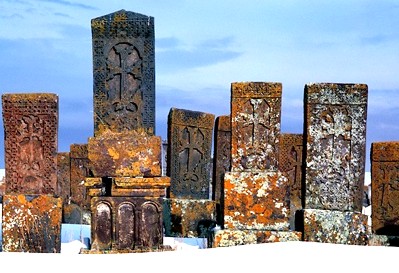
ANCIENT SNOW-COVERED CROSS-STONE FIELD OF
N O R A T U S
Dry subtropical climate in the foothills of the northeastern and
south-eastern areas of the Republic, up to an elevation of 900 m above sea
level. The mean winter monthly temperature of the air is about 0 Cº, and the
absolute minimum is minus 25 Cº. The snow coat is rarely stable. Spring sets in
early in the second half of February Spring weather is uncertain . The summer is
long-more than four months-and dry. The days are most commonly hot and
cloudless. It rains very seldom.
In July and August the heat rises during the daytime to 36 - 41 Cº. The frostless
period. lasts more than 250 days. This climate favors cultivation of thermophilic plants - figs, pomegranates, peaches, quinces, grapes, etc. .
Autumn is the longest season in the Armenian foothills. There is little rainfall
an average of 250-300 mm. a year, the most is 500 mm. in the north-east.
Another type of climate is the dry continental type. It prevails along the middle reaches of the Arax up to an elevation of 1,300 m. It differs from the dry subtropical climate by its cold winters. The mean January temperature ranges from minus 4 to minus 6 Cº. The absolute minimum is minus 33 Cº. In this area the vines are covered with earth or buried for the winter, and the cultivation of subtropical plants is limited since peach and apricot trees freeze during rigorous winters (as was the case in the winter of 1963/64).Windless, cloudy weather prevails in winter. The spring is short with frequent thunderstorms. The summer is long, dry and hot, and autumn is warm and stable. The rainfall is insignificant -200 - 300 mm.
The foothills up to an elevation of 1,700 m in the valley of the middle reaches of the Aras, and the other areas up to an elevation of 1,200 m are characterized by a moderately warm dry climate. Winter in these areas is moderately cold and is noted for its stable snow coat. The summer is cool. The mean monthly temperature does not rise above 22 Cº. The temperature very rarely rises above 30 Cº (the absolute maximum is 36 Cº). The moisture conditions of this climate allow part of the areas to be used for dry farming. The main crops here are tobacco, cereals, fruit and in some places grapes.
A temperate climate is to be found in the mid-mountain areas up to an
elevation of 2,000 m. It is characterized by sufficient moisture and a fairly
uniform distribution of rainfall according to seasons, which is particularly
important for agriculture.
The winters differ within this zone, and the temperate climate of the
mid-mountains must therefore be divided into two subtypes: a forest climate with
a mild winter (a mean monthly winter temperature of minus 4 Cº)
and a steppe climate with a cold winter (- 81 Cº) . The Snow coat in the moderate zone is
stable and lasts rather long. The summer is cool and comparatively humid; it is
hardly ever hot. The mean temperature of the summer months does not exceed 20 Cº;
the maximum is 35 Cº. The crops cultivated in these areas are cereals, potatoes
and more rarely tobacco; the fruit crops include apples. pears and plums.
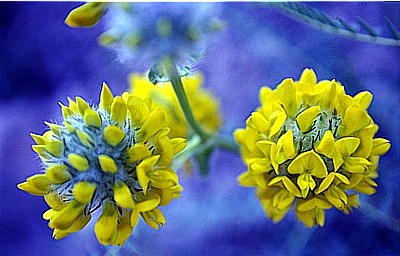
F L O W E R S O F T
H E A R M E N I A N
H I G H L A N D
This climate of the Armenian Plateau is very healthy.
The cold mountain climate may be divided into two subtypes: the lower sub-zone (up to 2,500 m.), where cereals, beet and potatoes are grown, and the upper sub-zone with a severe winter and a heavy snow coat (up to 2 m.). It is the climate of alpine and sub-alpine meadows, an area of vast pastures. In this area snow can be seen in depressions high up in the mountains, in the shade of cliffs all the year round.
A rigorous alpine climate reigns on the mountaintops rising more than 3,500 m above sea level. Here the winter lasts six months accompanied by sharp frost and fierce snowstorms. The summer is short and cold. The peaks of Aragats and Kapuytjugh are covered with snow all the year round.
![]()